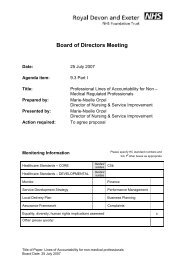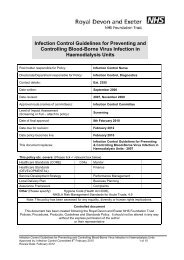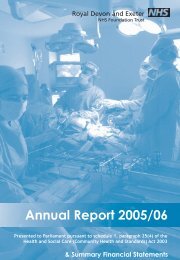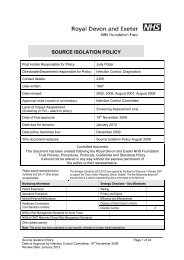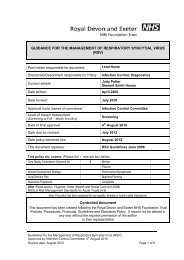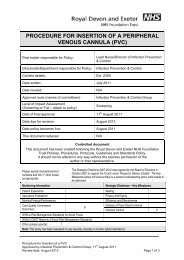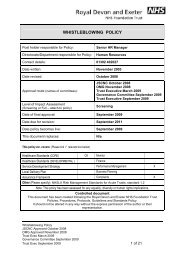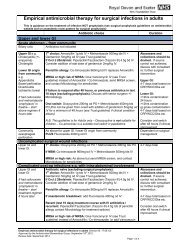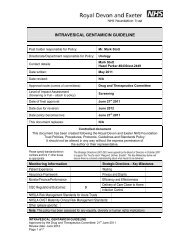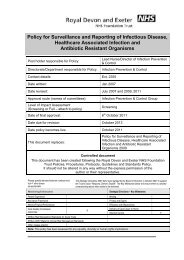Annual Report and Accounts 2012/13 - Royal Devon & Exeter Hospital
Annual Report and Accounts 2012/13 - Royal Devon & Exeter Hospital
Annual Report and Accounts 2012/13 - Royal Devon & Exeter Hospital
You also want an ePaper? Increase the reach of your titles
YUMPU automatically turns print PDFs into web optimized ePapers that Google loves.
2. Our Trust <strong>Royal</strong> <strong>Devon</strong> <strong>and</strong> <strong>Exeter</strong> NHS Foundation Trust 51<br />
<strong>Annual</strong> <strong>Report</strong> <strong>and</strong> <strong>Accounts</strong> <strong>2012</strong>/<strong>13</strong><br />
Sustainability <strong>Report</strong><br />
The Trust is committed to becoming a low carbon<br />
sustainable organisation.<br />
The regulatory <strong>and</strong> legislative<br />
requirements for the NHS to reduce<br />
carbon emissions <strong>and</strong> to adapt to<br />
climate change are taken seriously<br />
by the Trust. The Government is<br />
clear that carbon reduction needs to<br />
be systematically implemented <strong>and</strong><br />
more transparently reported. The<br />
Department of Health has produced a<br />
framework for the NHS for reporting<br />
sustainability as part of the annual<br />
NHS financial reporting process.<br />
Sustainability information from waste<br />
production to energy consumption is<br />
also gathered <strong>and</strong> reported through<br />
the m<strong>and</strong>atory Estates Return<br />
Information Collection (ERIC).<br />
The Trust has a Sustainability<br />
Committee which meets periodically<br />
<strong>and</strong> sets the overall agenda for the<br />
Trust’s sustainability strategy. The<br />
Trust also has a Sustainability Steering<br />
Group, the objectives of which are<br />
to promote the Trust’s sustainable<br />
development framework within which<br />
carbon emissions will be reduced.<br />
This group meets on a monthly basis<br />
<strong>and</strong> reports to the Sustainability<br />
Committee. In 2010, an action plan<br />
covering key sustainability areas of the<br />
Trust’s business was set out. The Trust’s<br />
carbon reduction strategy sets out<br />
proposals for sustainable development<br />
to bring about measurable<br />
improvements aimed at ensuring its<br />
economic, social <strong>and</strong> environmental<br />
sustainability. The Trust has consulted<br />
with its Members on sustainability <strong>and</strong><br />
its social responsibilities.<br />
The Board of Directors approved the<br />
Carbon Reduction Strategy at the<br />
September 2009 Board meeting <strong>and</strong><br />
have continued to receive updates on<br />
progress.<br />
Carbon Emissions<br />
The Trust aims to meet the NHS target<br />
of reducing its 2007 baseline carbon<br />
emissions, released through building<br />
energy consumption, by 10%, before<br />
2015. In 2010 the NHS Sustainable<br />
Development Unit published an<br />
update supplement to the NHS Carbon<br />
Reduction Strategy highlighting that<br />
in 2007 the carbon footprint for<br />
NHS Engl<strong>and</strong> was 21 million tonnes.<br />
This is broken down by proportion<br />
in the three primary sectors of travel<br />
(17%), building energy (24%) <strong>and</strong><br />
procurement (59%).<br />
In April 2011, the Trust had its carbon<br />
emissions independently verified to the<br />
recognised EU st<strong>and</strong>ard <strong>and</strong> may now<br />
use the CICS (Complete Integrated<br />
Certification Services) Carbon Verified<br />
Assurance Mark. The RD&E now joins<br />
only 37 Trusts in Engl<strong>and</strong>, including<br />
five other Trusts in the South <strong>and</strong> West,<br />
which have received the Assurance<br />
Mark.<br />
It is important to note that previous<br />
<strong>Annual</strong> <strong>Report</strong>s may contain different<br />
information regarding carbon emissions;<br />
this is because the Trust has previously<br />
used different emissions factors for<br />
calculating carbon dioxide equivalents<br />
(CO2e). This year the Trust is using<br />
the methodology required by the NHS<br />
Sustainable Development Unit.<br />
The Trust closely monitors its<br />
production of greenhouse gases from<br />
the sources described below. The<br />
Trust complies with the following<br />
legal instruments designed to improve<br />
energy <strong>and</strong> carbon efficiency:<br />
• Carbon Reduction Commitment<br />
(CRC)<br />
• European Union Emissions Trading<br />
Scheme* (EUETS)<br />
• Climate Change Levy (CCL).<br />
*This year the Trust has 'opted out'<br />
of the EUETS scheme. This does not<br />
mean that it has absolved itself of<br />
responsibilities. The Trust is now part<br />
of the 'UK Small Emitters <strong>and</strong> <strong>Hospital</strong>s<br />
Opt Out Scheme'. <strong>Report</strong>ing energy<br />
usage <strong>and</strong> a financial cost to carbon<br />
still apply, but the scheme is simplified<br />
to make it less burdensome than the<br />
full EUETS.<br />
The responsibilities required under<br />
legal obligations include:<br />
• Senior management accountability<br />
• Monitoring <strong>and</strong> reporting energy<br />
usage<br />
• Paying for energy use <strong>and</strong> carbon<br />
emissions.



